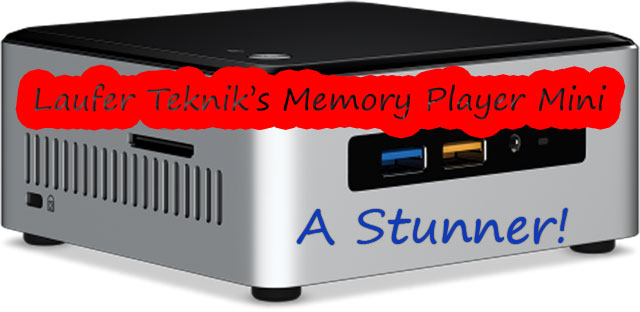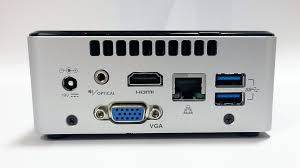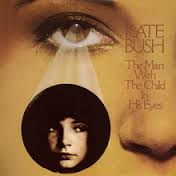Laufer Teknik Memory Player Mini

 I attended the New York Audio Show 2016, held at the Park Lane Hotel last November. It was a smallish affair but appeared well attended as New Yorkers came in droves. Upon my visit on the last day (Sunday), I came away with the Laufer Teknik Memory Player Mini to evaluate and possibly review. The Laufer Teknik suite (Room #806), sounded excellent with Ascend D9 loudspeakers, Behold electronics (Friday and Saturday) and Absolare Signature Integrated amplifiers (Sunday) that included the Sunny Cable technology cables and the MP Mini as source). The award-winning Memory Player 64 music server starts at $20,000 and up – too steep for this frugal audioboy, so the Mini’s $2495 entry level price caught me with both surprise and curiosity.
I attended the New York Audio Show 2016, held at the Park Lane Hotel last November. It was a smallish affair but appeared well attended as New Yorkers came in droves. Upon my visit on the last day (Sunday), I came away with the Laufer Teknik Memory Player Mini to evaluate and possibly review. The Laufer Teknik suite (Room #806), sounded excellent with Ascend D9 loudspeakers, Behold electronics (Friday and Saturday) and Absolare Signature Integrated amplifiers (Sunday) that included the Sunny Cable technology cables and the MP Mini as source). The award-winning Memory Player 64 music server starts at $20,000 and up – too steep for this frugal audioboy, so the Mini’s $2495 entry level price caught me with both surprise and curiosity.
I’ve spend many an hour at Clement Perry’s listening to his revealing system and, with The Memory Player as source, it’s never disappointed these ears. Time and again, he manages to coax even better sound out of this world class system, a feat that always stuns me. I spend most of my time luxuriating in the tunes CP plays and became only mildly curious as to what he’s actually doing when readying the next track(s) for play. Now I know!
People who know CP know he has a passion for great music and The Memory Play, being an early adopter from the first model to present. Being so associated with any brand has its pluses and minuses… CP actually makes an effort to disassociate himself from the brand other than that of an enthusiastic user. On the other hand, when the Memory Player Mini became available, he chose me to write on my experiences. That’s a plus for me!

The Mini Setup without too Many Hurdles
The Memory Player Mini is a diminutive unit, with the MP software is built into a PC with the form factor of a Mac Mini, approximately 4.5” w x 4.5” l x 2” h. The unit sports 4 USB 3.0 ports, one VGA and a single HDMI port, one Ethernet port, a headphone jack, optical port and an SDHC slot. I added an extra unpowered USB 3.0 hub for convenience and exported through the optical port due to the distance from desk to my rig for casual listening. For critical listening, the Mini can easily move closer for USB connection to the DAC.
 Over the next week I picked up affordable monitor, cables and mouse, et al. and Sam Laufer sent me an external Bluray drive, a rechargeable keyboard and a 256gb external SSD drive (which will hold about 128 CDs worth of music according to an older article by CP). After some internet searches and a few questions asked of Memory Player-owning friends, I had the MP Mini up and running from my desk to the Arcam irDAC ll and into my preferred system for this review. The ‘hardest’ part in preparing myself for Mini use was wrapping my long-time Mac using head around the Memory Player software being housed in a PC… a mental hurdle that proved to be just a silly bit of anxiety on my part. The Memory Player Mini software is easily accessible and it’s GUI improvements over it’s previous version an improvement. Other than a little time understanding the PC drive structure, general etiquette, and a little time spent poking around, I was importing CD’s into JRiver Media Center 22 promptly.
Over the next week I picked up affordable monitor, cables and mouse, et al. and Sam Laufer sent me an external Bluray drive, a rechargeable keyboard and a 256gb external SSD drive (which will hold about 128 CDs worth of music according to an older article by CP). After some internet searches and a few questions asked of Memory Player-owning friends, I had the MP Mini up and running from my desk to the Arcam irDAC ll and into my preferred system for this review. The ‘hardest’ part in preparing myself for Mini use was wrapping my long-time Mac using head around the Memory Player software being housed in a PC… a mental hurdle that proved to be just a silly bit of anxiety on my part. The Memory Player Mini software is easily accessible and it’s GUI improvements over it’s previous version an improvement. Other than a little time understanding the PC drive structure, general etiquette, and a little time spent poking around, I was importing CD’s into JRiver Media Center 22 promptly.
 When importing via CD, The Memory Player Mini processing of tracks is automated – the songs are copied to your preferred drive and automatically brought into JRiver Media Center 22 with track names and cover art, when possible. They say never get rid of your source material and I’m glad I still have my CD collection – it pales in comparison to my (exhaustive) digital library, but it was handy to start the importing process with some of my preferred demo discs. Bringing in music from thumb drive proved easy as well, once I was comfortable with the process of importing and adding to JRiver MC. Again, it was just understanding the similarities and differences from iTunes, which I use with Amarra HiFi for high resolution play. Songs added to your music drive from thumb drive aren’t processed nor auto-added to JRiver MC, so you need to process them with the Mini’s Upsampler to bring them up to 32-bit Wave64 format where the Memory Player’s software does its magic.
When importing via CD, The Memory Player Mini processing of tracks is automated – the songs are copied to your preferred drive and automatically brought into JRiver Media Center 22 with track names and cover art, when possible. They say never get rid of your source material and I’m glad I still have my CD collection – it pales in comparison to my (exhaustive) digital library, but it was handy to start the importing process with some of my preferred demo discs. Bringing in music from thumb drive proved easy as well, once I was comfortable with the process of importing and adding to JRiver MC. Again, it was just understanding the similarities and differences from iTunes, which I use with Amarra HiFi for high resolution play. Songs added to your music drive from thumb drive aren’t processed nor auto-added to JRiver MC, so you need to process them with the Mini’s Upsampler to bring them up to 32-bit Wave64 format where the Memory Player’s software does its magic.
So, what was CP doing during our listening sessions? He was dropping processed Wave64 files onto ’Burn Memory’ slots in his Memory Player 32, then dropping that converted file into JRiver, and playing from JRiver. This provides a noticeable improvement over just playing from JRiver referencing the Music drive. The Mini has just a single slot that’s slightly less than 4gb in size, but that’s enough space to collect a handful of songs for any critical listening sessions. It’s easy enough to add and delete files a small sample of files for critical listening. Sam Laufer confirmed that most people just play their music files through the JRiver – it’s a good sounding, convenient and the process to accomplish.
I tried the Mini’s headphone jack with some headphones and got no signal. I’m no Window’s whiz… I figured it was something Sam could help me with (he did, willingly). Prior to his helping, the first part of my listening was accomplished optically through the Arcam irDAC ll.
The Tale of One CD
 They say Kate Bush hasn’t performed live for 35 years. I still remember seeing her live on SNL back in 1978 singing and emoting The Man With The Child In His Eyes seductively from atop Paul Schaeffer’s grand piano. Thankfully her son pushed her to perform live again and, in 2014, Kate sold out 22 shows at the old Odeon in London. The performance was recorded and has been released in a 3 CD (4 LP vinyl) set as “Before The Dawn.” It was also filmed but a DVD, as yet, has not been announced. The years have been kind to Kate and this wonderful recording shows her in commanding form with a talented backing troop.
They say Kate Bush hasn’t performed live for 35 years. I still remember seeing her live on SNL back in 1978 singing and emoting The Man With The Child In His Eyes seductively from atop Paul Schaeffer’s grand piano. Thankfully her son pushed her to perform live again and, in 2014, Kate sold out 22 shows at the old Odeon in London. The performance was recorded and has been released in a 3 CD (4 LP vinyl) set as “Before The Dawn.” It was also filmed but a DVD, as yet, has not been announced. The years have been kind to Kate and this wonderful recording shows her in commanding form with a talented backing troop.
I first played the entirety of Act lll from the MP Mini’s upsampling and conversion of CD tracks to Wave64 files through JRiver Media Center 22 with the MP Mini out to the Arcam irDAC ll. I followed this with playing the same material on the CD using the Metronome (unbalanced) and continued by copying a couple of the tracks to the Mini’s Burn Memory slot and then playing them through JRiver and out to the Arcam. Finally, I moved the CD rips to my MacBook Pro and played lossless files with Amarra HiFi out to the Arcam irDAC ll. The Arcam irDAC ll is nested in my main rig and I listened through my Eminent Technology LFT8b speakers.
This appears to have been a wonderful and dynamic theater performance. The tracks played on the Memory Player Mini through JRiver MC presented a nice depth to Kate’s vocal, with a nice depth and imaging to the light ambient bird sounds. The piano wasn’t too up front, but it was solid, spaced nicely across an ample soundstage. Drums came in with punch and crisp rim shot transients, accompanied by solid, yet subtle, bass playing. The bells and chimes imaged well with nice depth and transparency. When the music came together and got dense, the image held together without compressing and the bass got very full. The pulsating bass and powerful string/synth accompaniment was intense, followed by the big dense chorus, which got just a touch edgy.
The next section of Act lll began with a solitary monologue from a painter creating, injecting a bit of humor on the stage, followed by some very deep bass, strong percussive attacks, with a nice depth to the stage. Kate’s vocal was crisp and airy. Reviewing my notes, I didn’t recall ever hearing such full bass from my system.
Things got a lot more interesting when I copied two of the tracks into the Mini’s Burn Memory and played them from jRiver as recommended (playing them directly from the Burn Memory slot introduces a great deal of jitter). The performance was far more dynamic and had greater depth. The powerful bass growled, Kate’s vocals yielded better body, bass, depth and resolution. Strings and synths were more dominant and the overall presentation had better pacing and far more rhythmic. The latter track was fuller, bolder, more forceful and insistent. The bird sound had greater width and lightness and the cloudburst near end was more resonant. The Memory Player Min stepped forward with authority. This explains why CP takes the time to play tracks from his MP 32’s Burn Memory slots!
For comparison’s sake, I played the same lossless files through my MacBook Pro with Amarra HiFi and out to the Arcam irDAC ll. It’s said we tend to hear what’s missing more than what’s added and, in this case, it proved true. The opening piano was less localized and it appeared a touch muddy and less resolved. There was less sparkle to the ambient sounds. The bass did have boom and bloom but the sea gull sounds were less focused, as were Kate’s vocals. Strings and synths had less depth, there were constrained dynamics to the percussion and rim shots lost their crispness. Bass notes lost their singularity and were a touch muddy and congealed. The density in the large vocal chorus compressed. There was power but it lacked resolution and nuance.
Oh, What A Difference RCA Makes
Sam Laufer slipped by and made a couple of upgrades to the Mini. He changed out the DAC chip and upgraded some capacitors. He and Mark Porzilli decided to simplify the interface, disabling the docks that pop down in the OS from on all sides of the desktop and placing all of the Memory Player software programs on a single desktop with some Windows apps, explaining that, while the docks make for easy access, the docks gobble up RAM the would be available for the MP software. Sam commented that I might want to come out of the headphone jack and bypass the Arcam irDAC ll, going directly into the preamp and he made the proper selections in the Mini’s software to allow output from the headphone jack.
After Sam Laufer left, I listened with headphones through the line level output of the Mini phone jack – the level out to my Sennheiser HD650’s was perfect with no external connection necessary to my EarMax headphone amp. After suitable break-in, I moved the Mini and display to a rack of components currently under review. connecting the Mini to the integrated amplifier with RCA’s from the Mini’s 3.5mm headphone jack.
Accessing the Memory Player software on the desktop appeared a new challenge – things looked different and some of the MP apps had different names. With a bit of back and forth via telephone and texting with Sam, familiarity with the new layout ensued. Some of the JRiver settings needed tweaking and Sam pleasantly dove in over the internet – it was illuminating to watch him work from the screen and I learned a bit about the variety of settings in JRiver. Initially we had hoped to set up a zone that allowed the Mini to play out to my system] and to headphones simultaneously but that proved a bit glitchy, so we settled on separate zones to select headphone or player, a practice that’s much more stable be more stable. No biggie, such things are easy to select.
Mini Jack, Mini WOW!
Shortly after the Mini settled in with it’s new upgrades, we had brother Tim over and played the Mini throughout the evening. As good as the Mini was playing through the Arcam irDAC ll, on it’s own the Mini’s presentation deepened with greater resolution thanks to it’s new DAC chip and capacitors. Tim’s quick take was “it’s far more expansive with more thrust in the room. Easy and effortless.” Robin was even more succinct, exclaiming “It’s yummy!”
What the Mini offers through it’s own DAC is simply stunning. In the past, I’ve tended to dismiss products that pass audio through a 3.5 mm mini jack, but not any more. Kate Bush’s ‘Prologue,’ from the album above, was light, airy and more dynamic. The presentation opened up, textures were more interesting, bass fuller and overall production more holographic. Vocals were lush, rim shots had more snap and the kick of the bass drum was more forceful. Bells rung deep in the mix felt like they were rung in real space. The overall work had tremendous bottom end for a live recording.
 Moving on to other music, I next played Bachianas Brasileiras No. 5, from Wayne Shorter’s Grammy Award-winning album, “Alegria” (Verve 2003). This track is notable for it’s beautiful cello work, played expertly with tremendous life and rosin just dripping from the bow. This is a very well recorded song, with Shorter’s wonderfully played sax set in a field of percussive clicks and taps and plentiful bass. The imaging is spot on and soundstage intimate and dimensional. A great album with truly great sound… award well-deserved.
Moving on to other music, I next played Bachianas Brasileiras No. 5, from Wayne Shorter’s Grammy Award-winning album, “Alegria” (Verve 2003). This track is notable for it’s beautiful cello work, played expertly with tremendous life and rosin just dripping from the bow. This is a very well recorded song, with Shorter’s wonderfully played sax set in a field of percussive clicks and taps and plentiful bass. The imaging is spot on and soundstage intimate and dimensional. A great album with truly great sound… award well-deserved.
Perhaps it was because the day was Valentines Day that I played Howard Hanson’s Symphony No. 2, Op 30 Romantic from “Hanson Conducts Hanson” (Phillips 2004), with Hanson conducting the Eastman-Rochester Orchestra. Howard Hanson’s long been one of my favorite American composers. This masterwork couples beauty and restraint with wonderful dynamics and great textures, delivering strings abuzz with warmth and veracity, french horns with very nice stage depth and joyously effervescent woodwinds. The dynamics just slay me – the basses pound and prod the movement forward. The body of the bass drum was massive when struck as bold strings sewed a bold fabric of gorgeous textures. The Mini rendered this well-imaged orchestral picture with verve and great resolve.
 Up next, a few tracks from Jeremy Pelt’s “Face Forward, Jeremy” (Highnote 2014), a project with percolating primarily acoustic instrumentation on a holographic soundstage. The first two tracks, ‘Glimpse’ and ‘Higby Part 1,’ songs with nice depth and angular lines, offered a rhythmic drive that brought ‘Bitches Brew’ to mind. The fierce playing drew me in and that rapid fire pace didn’t let go. Dense passages of percolating percussion paired with the natural sound of Pelt’s trumpet were presented very well by the Mini. The fourth track, ’Rastros’, featured a wonderful female vocal, accompanied by a harp, bowed bass, a sweet sax and Pelt’s own muted trumpet offered a nice respite – glorious and passionately rendered with great depth and detail by the MP Mini.
Up next, a few tracks from Jeremy Pelt’s “Face Forward, Jeremy” (Highnote 2014), a project with percolating primarily acoustic instrumentation on a holographic soundstage. The first two tracks, ‘Glimpse’ and ‘Higby Part 1,’ songs with nice depth and angular lines, offered a rhythmic drive that brought ‘Bitches Brew’ to mind. The fierce playing drew me in and that rapid fire pace didn’t let go. Dense passages of percolating percussion paired with the natural sound of Pelt’s trumpet were presented very well by the Mini. The fourth track, ’Rastros’, featured a wonderful female vocal, accompanied by a harp, bowed bass, a sweet sax and Pelt’s own muted trumpet offered a nice respite – glorious and passionately rendered with great depth and detail by the MP Mini.
Conclusion
Utilizing it’s own upgraded DAC and caps, the Mini is a stellar performer (and it was a solid player prior to the upgrade). For casual listening, playing digital files through JRiver Music Center on the MP Mini sounded very, very good. Playing select tracks in JRiver with the Burn Memory slot when listening critically provided a noticeable improvement. Oh, if only there were more room on the Burn Memory slots (!)… but that’s what the bigger, far more expensive Memory Player is all about. To that end, I find the Memory Player Mini to be an extraordinary value. Until experiencing the Mini, I hadn’t had such great sounding digital playback in my system. It’s clear, at least to this listener, that the future of digital playback is software-based, not from hard copy. The Laufer Teknik Memory Player Mini is a stunner.
![]()
greg voth
Specifications:
The Mini is bundled with JRiver 22 pre-optimized for the best playback. Runs with Roon, iTunes, or any other player of your choice. The Mini is built upon an Intel-based mini PC platform. In the coming months, we will be releasing mini versions of our Octuple DSD (DSD512, 22, 5792 MHz) and 768 kHz PCM capable DAC, which will connect to The Memory Player Mini along with our DC power filtering and regeneration power products.
Price: $2,495.00
Address:
Laufer Teknik
360 Southbury Road
Roxbury, CT 06783
Phone: Phone: 917-535-8888
Website: www.lauferteknik.com
email: slaufer@lauferteknik.com
Stereo Times Masthead
Publisher/Founder
Clement Perry
Editor
Dave Thomas
Senior Editors
Frank Alles, Mike Girardi, Russell Lichter, Terry London, Moreno Mitchell, Paul Szabady, Bill Wells, Mike Wright, and Stephen Yan,
Current Contributors
David Abramson, Tim Barrall, Dave Allison, Ron Cook, Lewis Dardick, John Hoffman, Dan Secula, Don Shaulis, Greg Simmons, Eric Teh, Greg Voth, Richard Willie, Ed Van Winkle, Rob Dockery, Richard Doron, and Daveed Turek
Site Management Clement Perry
Ad Designer: Martin Perry





Be the first to comment on: Laufer Teknik Memory Player Mini